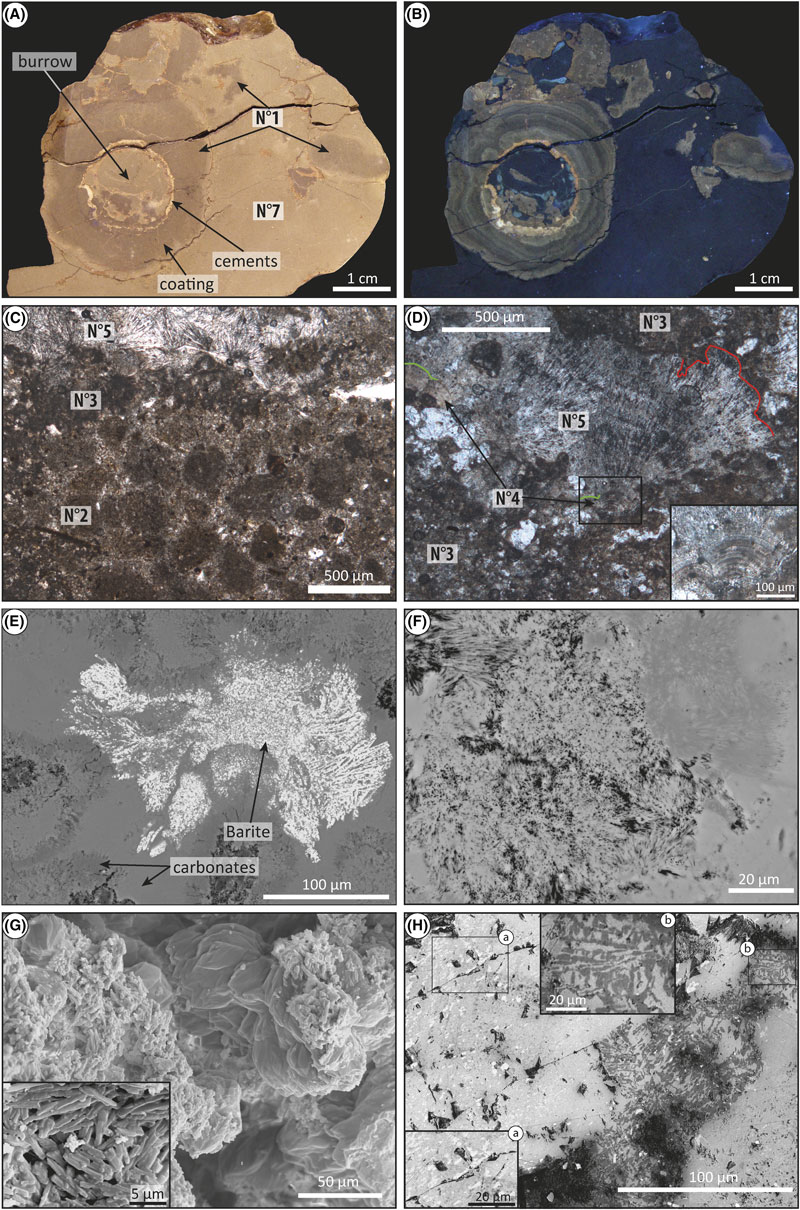The AAPG/Datapages Combined Publications Database
AAPG Bulletin
Figure
AAPG Bulletin; Year: 2017; Issue: August DOI: 10.1306/10171616021
Return to Full Text

Figure 8. Petrographic features of early diagenetic minerals. (A) Polished slice of a mound sample: gray nodules (micrite N°1) are embedded within the brown matrix (microsparite N°7). The indicated burrow is coated by micrite (N°1) and lined by cements. (B) View of the same sample under ultraviolet light. Micrite (N°1) is strongly fluorescent, visualizing concentric rims around the burrow. (C) Peloid-rich micrite (N°2) covered by a micritic rim (N°3) and aragonite fans (N°5). (D) Typical succession of minerals forming the elementary sequence (ES): micritic rim (N°3), botryoidal aragonite (N°4), and fans of aragonite (N°5). The upper part of the aragonite fans is corroded (underlined by the red sinuous line). (E) Backscattered electron–scanning electron microscope (BSE–SEM) picture showing the micritic rim (N°3) composed of fibrous barite and several carbonate phases. (F) A BSE picture of the micritic rim (N°3) showing fibrous carbonates. (G) An SEM picture showing the micritic rim (N°3) with subhedral crystals covered by randomly orientated elongated crystals. The insert shows a representative example of the elongate crystals at a higher magnification. (H) A BSE picture of the micritic rim (N°3). Detail a shows bright (Sr-rich), aligned, elongated crystals. Detail b shows dark (Mg- and Mn-rich), dendritic crystals. Note: A color version can be seen in the online version.

Figure 8. Petrographic features of early diagenetic minerals. (A) Polished slice of a mound sample: gray nodules (micrite N°1) are embedded within the brown matrix (microsparite N°7). The indicated burrow is coated by micrite (N°1) and lined by cements. (B) View of the same sample under ultraviolet light. Micrite (N°1) is strongly fluorescent, visualizing concentric rims around the burrow. (C) Peloid-rich micrite (N°2) covered by a micritic rim (N°3) and aragonite fans (N°5). (D) Typical succession of minerals forming the elementary sequence (ES): micritic rim (N°3), botryoidal aragonite (N°4), and fans of aragonite (N°5). The upper part of the aragonite fans is corroded (underlined by the red sinuous line). (E) Backscattered electron–scanning electron microscope (BSE–SEM) picture showing the micritic rim (N°3) composed of fibrous barite and several carbonate phases. (F) A BSE picture of the micritic rim (N°3) showing fibrous carbonates. (G) An SEM picture showing the micritic rim (N°3) with subhedral crystals covered by randomly orientated elongated crystals. The insert shows a representative example of the elongate crystals at a higher magnification. (H) A BSE picture of the micritic rim (N°3). Detail a shows bright (Sr-rich), aligned, elongated crystals. Detail b shows dark (Mg- and Mn-rich), dendritic crystals. Note: A color version can be seen in the online version.